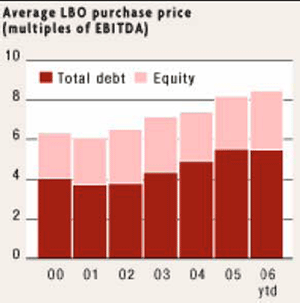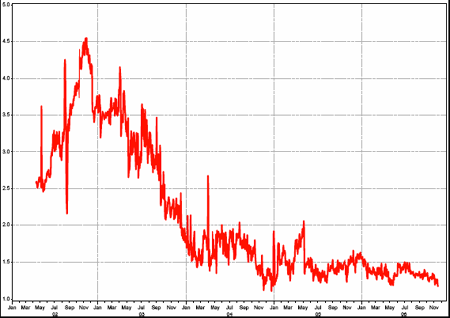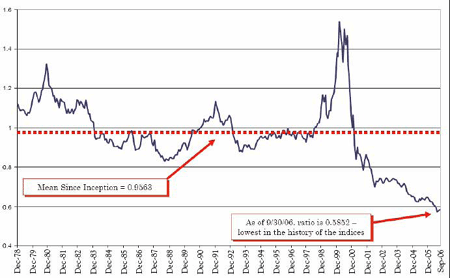What buyout fever means for markets
Private equity is on a roll. November has seen unprecedented activity levels in the buyout market. Why is this? And what does it mean for bonds and equities?
Not so long ago a Swedish pension fund manager, who shall remain unnamed in order to protect his good name and reputation, stated publicly that "he was never going to invest in another hedge fund. Returns were simply not attractive enough. Going forward, he would concentrate his alternative investment allocations on private equity." Amen.
Earlier this year, the annual Cap Gemini World Wealth Report confirmed that the average high net worth investor harbours similar views. Allocations to hedge funds amongst private investors are dwindling whereas private equity allocations are on the rise all over the world. Now, with the risk of stepping on the toes of one or two of our clients, let's remind ourselves what we learned from the previous private equity cycle which came to an abrupt end in 2001-02. We learned that all the sales talk about private equity funds providing non-correlated returns was mumbo jumbo. Contrary to what we had been told, private equity behaved no differently from any high-beta (i.e. highly volatile) listed stock.
But, most importantly, we learned that the best time to invest in private equity is when the industry cannot raise money even if their lives depended on it. And the worst time to invest is when the industry is bursting with cash. Such as now.
MoneyWeek
Subscribe to MoneyWeek today and get your first six magazine issues absolutely FREE

Sign up to Money Morning
Don't miss the latest investment and personal finances news, market analysis, plus money-saving tips with our free twice-daily newsletter
Don't miss the latest investment and personal finances news, market analysis, plus money-saving tips with our free twice-daily newsletter
The last couple of weeks have seen unprecedented activity in the private equity arena with some of the largest players keen to dispense of vast sums of money before the end of the year when they next have to report to their investors. In the world I was brought up in, we had a word for this sort of behaviour. We called it window dressing.
The current wave of buyouts is different
Anyway, the current wave of buyouts distinguishes itself from the previous one in several ways. First and foremost, the momentum has shifted from North America to Europe. More deals are now done outside than inside the US. Europe is the main beneficiary of this trend and this at least partly explains why European equities continue to outperform US equities. (For more on this, see: Buyouts give Europe a boost).
Secondly, most deals in this cycle are cash transactions as opposed to the previous cycle where stock deals dominated. This holds important implications for global stock markets because every time a cash deal is executed, a significant sum of money has to be recycled into other equities. In other words, private equity transactions provide significant and ongoing support to equity prices.
Thirdly, more activity is now financed through loans secured as well as unsecured - and through the issuance of corporate bonds as opposed to equity, when compared to the last cycle. About six or seven years ago a typical leveraged buyout would include 30-40% equity participation. Now that number is down to 15-25%. (For more on debt-financed buyouts, see: Leveraged loans: expect a bloodbath).
Reasons for the low equity participation rate
You may wonder why the average private equity manager is comfortable with such a low equity participation rate. The explanation may be found in the holding period for a typical private equity investment. The offering memorandum of a private equity fund will tell you that you should be prepared to be invested for the next seven to ten years. The reality is very different, though. According to the latest data from Thomson, the average holding period is now about 2 years. Another reason why the equity (and senior loan) participation has dropped is the appearance of new instruments in recent years. Second lien loans, mezzanine notes and PIK notes (payment-inkind) have all emerged in the last few years. For example, in 2003, senior loans made up 62% of all loan finance in an average European LBO compared with 33% now. The commercial banks play a key role in financing a leveraged buyout, although the role has changed somewhat over time. Five years ago, 95% of the loans ended up in the banks' own portfolios. Today, the banks still facilitate the vast majority of loans but about 50% is passed to institutional investors such as CLO funds and hedge funds. In short, this is how a typical transaction works:
When a private equity manager decides to bid for a company, his first call is to the bank(s). This conversation will establish how much finance the bank is prepared to provide. As the propensity to lend - and the desire amongst institutional investors to invest - is at an all time high, the private equity manager will usually find that he has more capital available than at any point in the past.
Now, if the average private equity manager has access to more capital than ever before, he can obviously afford to pay a higher price. With more private equity funds in operation than ever before, this can only lead to higher multiples being paid for the average buyout. This was confirmed in a recent survey conducted by the Financial Times (see chart 1), which suggests that the average EBITDA1 multiple paid has risen from just over 6 times to in excess of 8 times in the past six years alone.
A typical transaction five years ago would look like this:
Senior secured loans: 3.0-3.5 x EBITDA
Including high yield: 4.5-5.0 x EBITDA
Including equity: 6.0 x EBITDA
Today the picture is quite different:
Senior secured loans: 4.5-5.0 x EBITDA
Incl. second liens, mezz. & HY: 6.5-7.0 x EBITDA
Including equity: 8.25 x EBITDA
Chart 1: buyout prices on the rise

The buyout activities are being further helped by record low credit spreads as shown in chart 2. The chart illustrates the spread between BBBs and AAAs; however, a typical leveraged buyout will consist of bonds with a credit rating of B. Five years ago a B-rated corporate bond would trade at perhaps 650 basis points over the corresponding AAA paper. Now that spread has been reduced to 450-480 basis points.
Chart 2: Yr UST v. BBB Spread

What the sales person doesn't tell you, though, is that the capital structure in many of these buyouts is vastly different from the picture only five or six years ago when we experienced the last recession. Over the past 20 years, the average recovery rate for a high yield bond in default has been around 40%.
Today, should the EBITDA multiple drop to 5-6 times in a credit crunch-like situation, most senior secured loans will still be in-the-money but the recovery rate on a typical high yield bond could drop to close to zero and your investment could be wiped out. This is a very good reason not to fill your portfolio up with corporate bonds these days!
We suspect that the market is perhaps getting a little bit complacent as a result of default rates being unusually low in recent times. The long term average is about 4.5-5%. Year to date, the default rate has been as low as 0.47%.
Back to the buyout story. Short of a substantial financial accident or a major economic slowdown, we do not see an immediate slowdown of leveraged buyouts. There is simply too much money flushing around the system. There will be an accident at some point, though. We would be very surprised if one or several of the existing buyouts do not keel over in the next recession. If it were to happen to one of the high profile names that could fundamentally change the market.
How to profit from the buyout wave
In the meantime, the buyout wave will continue to provide stimulus to global stock markets. In recent months, we have come across numerous stock market commentators who have made the point that the market is overdue for a style shift back to growth stocks. As you can see from chart 3 below, value stocks have outperformed growth stocks every year since 2000 and are starting to look relatively expensive.

What you must remember, though, is that the vast majority of all leveraged buyouts are picked from the value basket. So, if buyouts continue to fuel global stock markets, value stocks will most likely outperform growth stocks. At the other end of the capital structure, there are now several funds specialising in secured bank loans. So if you want to participate in the buyout wave, but do not like to be tied up for five years or longer in a private equity fund, you can do it through either value stocks or through funds which specialise in secured loans. We would be happy to provide specific ideas in either area. Just don't play the high yield market. That is indeed an accident waiting to happen.
By Niels C. Jensen, chief executive partner at Absolute Return Partners LLP. To contact Niels, email: njensen@arpllp.com
Get the latest financial news, insights and expert analysis from our award-winning MoneyWeek team, to help you understand what really matters when it comes to your finances.
MoneyWeek is written by a team of experienced and award-winning journalists, plus expert columnists. As well as daily digital news and features, MoneyWeek also publishes a weekly magazine, covering investing and personal finance. From share tips, pensions, gold to practical investment tips - we provide a round-up to help you make money and keep it.
-
 Autumn Budget tax changes: how is your generation affected?
Autumn Budget tax changes: how is your generation affected?The chancellor expects everyone to do their bit to boost the nation's finances but the tax burden is by no means shared equally
-
 Revealed: pension savers ditch investment trusts and favour passive funds
Revealed: pension savers ditch investment trusts and favour passive fundsDemand for investment trusts is cooling among self-invested personal pension (Sipp) customers, who are increasingly choosing money market funds, passive funds and individual shares

